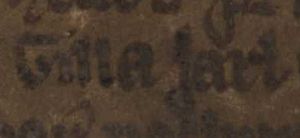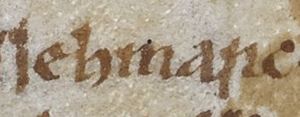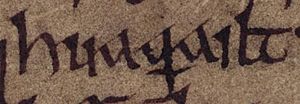Ragnall mac Gofraid facts for kids
Quick facts for kids Ragnall mac Gofraid |
|
|---|---|
| King of the Isles | |

Ragnall's name as it appears on folio 35r of Oxford Bodleian Library Rawlinson B 489 (the Annals of Ulster).
|
|
| Predecessor | Gofraid mac Arailt |
| Died | 1004 or 1005 Munster |
| Issue | Echmarcach?, Cacht?, Amlaíb? |
| House | probably Uí Ímair |
| Father | Gofraid mac Arailt |
Ragnall mac Gofraid was a powerful ruler known as the King of the Isles. He lived around the year 1000 and was likely part of a famous family called the Uí Ímair. His father was Gofraid mac Arailt, King of the Isles.
During Ragnall's time, the Kingdom of the Isles faced challenges. Another strong leader, Sigurðr Hlǫðvisson, Earl of Orkney, from Orkney, was expanding his power. Ragnall's father, Gofraid, died in 989. Ragnall himself passed away in 1004 or 1005.
Ragnall may have faced rivals like Gilli, a leader from the Hebrides who was close to Sigurðr. Another possible opponent was Sveinn Haraldsson, King of Denmark. He attacked the Isle of Man in 955. The English King, Æthelræd II, King of the English, also attacked Mann in 1000. These attacks might have been revenge for earlier events.
Ragnall died in Munster, a region in Ireland. We don't know exactly why he was there. He might have been exiled from the Isles. Or, he might have been trying to form an alliance with Brian Bóruma mac Cennétig, King of Munster. Brian was a very powerful Irish king.
After Ragnall's death, Brian Bóruma became the high king of Ireland. His power seemed to reach into the Irish Sea and northern Britain. Ragnall's possible brother, Lagmann mac Gofraid, was later found on the European mainland. This might mean Brian forced him out of the Isles.
Later, a possible son of Lagmann died fighting Brian's forces in 1014. With no strong local leader, the Isles might have come under the rule of the Norwegian Hákon Eiríksson. After Hákon's death, Echmarcach mac Ragnaill, King of Dublin and the Isles, who might have been Ragnall's son, rose to power. Ragnall may have had other children, including a daughter named Cacht ingen Ragnaill.
Contents
Who Was Ragnall, King of the Isles?
Ragnall was the son of Gofraid mac Arailt, King of the Isles. He belonged to a family called the Meic Arailt. This family was named after his grandfather, Aralt. Aralt might have been part of the Uí Ímair family.
From 972 to 989, Ragnall's father, Gofraid, was very active in the Irish Sea area. After Gofraid's death, the political unity of the Kingdom of the Isles seemed to weaken. This might have been due to attacks from Orkney in the 980s.
Challenges from Orkney
There is evidence that Sigurðr Hlǫðvisson, Earl of Orkney, tried to extend his power into the Isles. This happened in the late 900s and early 1000s. Old Norse stories say that Sigurðr led many raids into the Isles.
For example, the Njáls saga says that one of Sigurðr's men collected taxes from the northern Hebrides. This area was controlled by a local leader named Gilli. Other stories mention attacks by Sigurðr's allies in the Hebrides, Kintyre, Mann, and Anglesey. The Orkneyinga saga also talks about Sigurðr's raids in the Hebrides. The Eyrbyggja saga says his forces reached Mann and collected taxes there.

It's not clear how much power Gofraid had in the Hebrides. He seemed to share power with Gilli, and Orkney's influence was uncertain. We also don't know for sure who took over after Gofraid. Ragnall might have become king. It's possible that Gilli or Sigurðr took advantage of Gofraid's death to expand their control.
Ragnall was recognized as King of the Isles by the time he died. He likely faced opposition from Sigurðr during his rule. The Njáls saga mentions that Sigurðr and his men defeated a king on Mann named Gofraid. They then plundered the Isles. This king might have been Ragnall's father, or it could have been Ragnall himself.
The large number of silver hoards found in Mann and other Scandinavian parts of Scotland from around 1000 shows the wealth of Sigurðr's lands. These hoards suggest his power was at its peak. Hoards found in Argyll from this time might show conflict between Sigurðr and Ragnall.
Danish King's Exile

Some time after Gofraid died, Sveinn Haraldsson, King of Denmark, was forced out of his own kingdom. A writer named Adam of Bremen says that Sveinn first went to the English King, Æthelræd II, King of the English. Then, he found shelter with a king of the "Scots."
This "king of the Scots" might have been Cináed mac Maíl Choluim, King of Alba, who ruled Scotland. However, the term "Scots" could also refer to the Irish. Adam of Bremen was not always well-informed about events in Britain. He might have been confused about the king's true identity. It's possible he was referring to a Scottish, Irish, Cumbrian, or Norse-Gaelic ruler.
Given Ragnall's position in the Irish Sea, Adam might have seen him as an Irish king. In 995, old Welsh records say that Mann was invaded by Sveinn. This attack might have been aimed at the Uí Ímair family. Ragnall did not seem to achieve the same success as his father. Sveinn's invasion happened during a struggle for Dublin between two other Viking leaders.
Ragnall's Death and Its Impact
Ragnall died in Munster, Ireland, in 1004 or 1005. His death is mentioned in several old Irish records. We don't know the exact reasons for his death. He might have been trying to take control of Limerick. Another idea is that he was exiled from the Isles. This could explain why no battle is mentioned with his death.

Alternatively, Ragnall's death in Munster could mean he was trying to form an alliance with Brian Bóruma mac Cennétig, King of Munster. Around the time of Ragnall's death, Brian was called "emperor of the Scots" in an old book. This title might mean he claimed authority over the Irish, the Vikings in Ireland and the Isles, and the Gaels of Scotland. This could show that Brian made a deal with Ragnall and other leaders from the Isles.
If so, Ragnall might have formed this alliance to fight against Sigurðr's growing power in the Isles. Whether Brian defeated Ragnall or they simply formed an alliance, Brian's influence in the Isles might have led to Sveinn's campaigns in the region. Sveinn might have been trying to reduce Brian's power.

There is evidence that Ragnall's family had an alliance with Brian's family. In 974, Ragnall's uncle, Maccus, attacked a monastery. He captured a king who was an enemy of Brian's family. Another record says that Ragnall's family met with Brian's family in 984. They exchanged hostages, which was a sign of a military agreement. This agreement suggests Brian's family wanted to unite the Vikings of the Isles against those in Dublin.

In 1006, Brian gathered a huge army and marched through northern Ireland. An old text claims that Brian's navy collected tribute from the English, Britons, and people from Argyll and Scotland. If Brian had supported Ragnall, this passage might reflect that relationship. Ragnall's ancestors had campaigned in Anglesey and Dál Riata. Their actions might have led to the English King Æthelræd's attack on Mann in 1000. So, Ragnall's family history and his possible alliance with Brian might explain Brian's claims of overseas power.
Brian clearly had a strong navy. In 1002, he campaigned with forces from Dublin. Four years later, Dubliners helped him again. So, Brian could have led operations to reassert his power in the Isles and Argyll after Ragnall's death.

Ragnall might have been forced out of the Isles by Sigurðr's expansion. Or, his death overseas could have created a power vacuum. This might have drawn Orkney's power into the region. Gilli, Ragnall's rival, might also have taken advantage of Ragnall's death. Ragnall's removal from the region might also have played a part in the invasion of England by Máel Coluim mac Cináeda, King of Alba, in 1006.
Ragnall's apparent brother, Lagmann mac Gofraid, was later found leading mercenary operations on the European mainland. This might mean Brian also took advantage of Ragnall's death and forced Lagmann into exile. In 1014, an old record describes Brian as "over-king of the Gaels of Ireland, and of the Foreigners, and of the Britons." This could mean Brian had power in the Isles, or at least wanted it.
This interference might have led some Islesmen to support other leaders against Brian at the Battle of Clontarf that year. Amlaíb mac Lagmainn, who was likely Lagmann's son, died fighting Brian's forces in that battle. Both Brian and Sigurðr also died. If Lagmann also died around this time, the lack of a suitable local leader for the Isles might explain why the region came under the control of the Norwegian Hákon Eiríksson.
Who Were Ragnall's Descendants?

Ragnall might have been the father of Echmarcach mac Ragnaill, King of Dublin and the Isles. Echmarcach first appears in history in the early 1000s. An old English record says he was one of three kings who met with Knútr Sveinnsson. Knútr ruled a large empire that included Denmark, England, and Norway.
Echmarcach meeting with the kings of Scotland suggests he was a "Scottish" ruler. His power base was likely in the Isles. This supports the idea that Echmarcach was Ragnall's descendant. If Hákon had ruled the Isles, his death in 1029 or 1030 might have opened the way for Echmarcach to rise to power.

There is also evidence that Ragnall had a daughter who married into the Uí Briain family. In 1032, an old record says that Donnchad mac Briain, King of Munster, married the daughter of a Ragnall. About twenty years later, this woman was identified as Cacht ingen Ragnaill. She was called the "Queen of Ireland." Like Echmarcach, Cacht's name suggests she was Ragnall's daughter or a close relative.
Ragnall might also have been the grandfather of Gofraid mac Amlaíb meic Ragnaill, King of Dublin. Gofraid's father, Amlaíb, might have been the father of another Sitriuc mac Amlaíb. This Sitriuc died in an attack on Mann in 1073. Years later, in 1087, two descendants of a Ragnall were killed in another invasion of Mann. Amlaíb might have been their father, or they could have been sons of Echmarcach or Gofraid mac Amlaíb meic Ragnaill.
Images for kids
-
Ragnall's name as it appears on folio 35r of Oxford Bodleian Library Rawlinson B 489 (the Annals of Ulster).
-
The name and title of Sveinn Haraldsson as it appears on folio 151r of British Library Cotton Tiberius B I (the "C" version of the Anglo-Saxon Chronicle): "Swegen cyning".
-
The name Sigurðr Hlǫðvisson as it appears on folio 12v of AM 45 fol (Codex Frisianus): "Sigvrðr Loðvisson".
-
The name of Brian Bóruma mac Cennétig as it appears on folio 15r of Oxford Bodleian Library Rawlinson B 488 (the Annals of Tigernach): ("Brian mac Cendéidigh").
-
The name of Gofraid mac Arailt as it appears on folio 59r of Oxford Jesus College 111 (the Red Book of Hergest): ("gotbric uab herald").
-
The name and title of Gilli as it appears on folio 4r of AM 162 B epsilon (Njáls saga): "Gilla jarl".
-
The name of Echmarcach mac Ragnaill as it appears on folio 67r of British Library Cotton Domitian A VIII (the "F" version of the Anglo-Saxon Chronicle): "Iehmarc".
-
The name and title of Cacht ingen Ragnaill as they appear on folio 18r of Oxford Bodleian Library Rawlinson B 488: ("Cacht ingen Ragnaill, rígan Erenn"). This source styles Cacht "Queen of Ireland",



